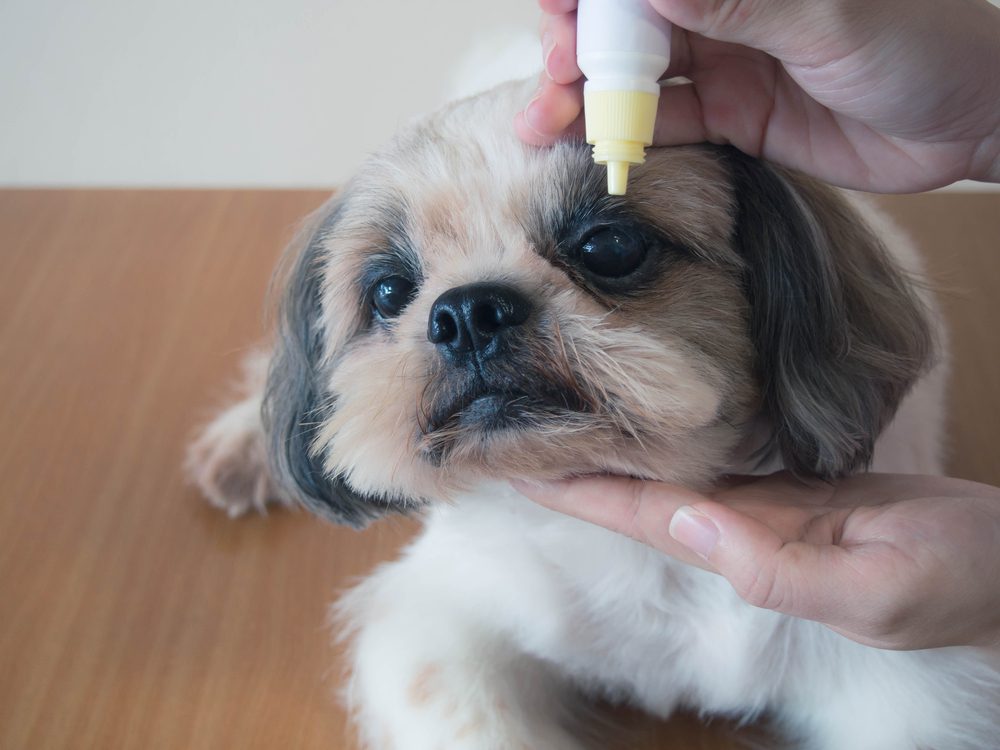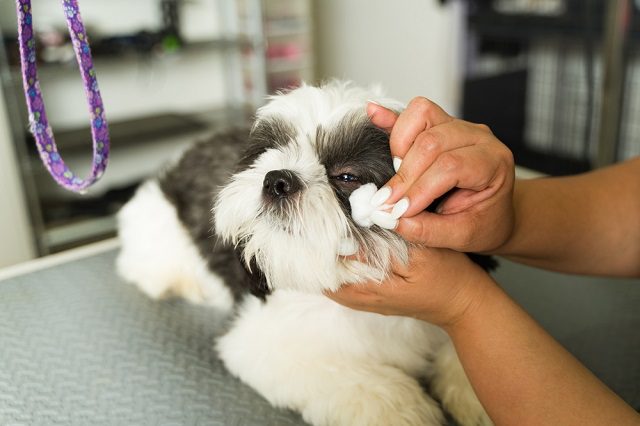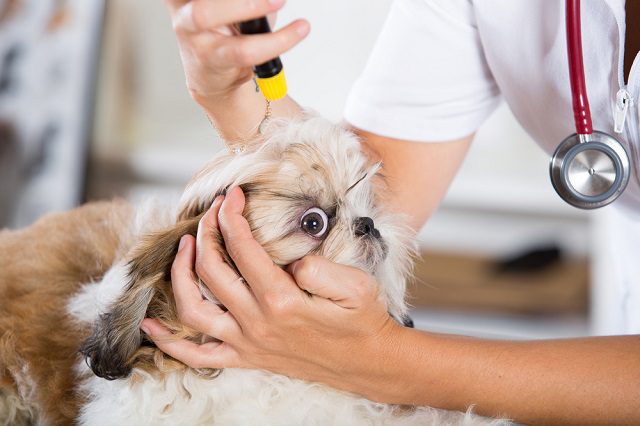Shih Tzu Eye Care: 17 Problems, Symptoms, and Treatments
When it comes to Shih Tzu eye care, it is essential to be aware of the potential eye problems that your furry friend may face and to take the necessary steps to prevent or treat those issues as needed. When it comes to Shih Tzu eye care, there are several problems that this breed may be prone to, ranging from minor irritations to more severe conditions.
This blog post will discuss the most common eye problems in Shih Tzus and their symptoms and treatments. We will also provide tips on how to prevent these problems from occurring.
So whether you are a first-time Shih Tzu owner or have cared for one for years, read this post!
Common Eye Problems in Shih Tzus with Symptoms and Treatments
1. Conjunctivitis
Conjunctivitis, also known as pink eye, is a common eye problem in Shih Tzus caused by an infection or irritation of the conjunctiva, the transparent membrane covering the white part of the eye.
Symptoms: Conjunctivitis includes redness, swelling, and discharge from the eye.
Treatment: Typically involves the use of antibiotics or anti-inflammatory medications.
2. Corneal Ulcers
Corneal ulcers are open sores on the surface of the eye that can be caused by injury, infection, or irritation.
Symptoms: Corneal ulcers include redness, pain, and discharge from the eye.
Treatment: Typically involves the use of antibiotics or anti-inflammatory medications. In some cases, surgery may be necessary to remove the ulcer.
3. Glaucoma
Glaucoma is a condition that results in increased pressure within the eye, which can damage the optic nerve and lead to vision loss.
Symptoms: Glaucoma includes pain, redness, and decreased vision.
Treatment: Typically involves using medication to lower the pressure within the eye. Surgery is sometimes necessary to relieve stress on the optic nerve.
4. Cataracts
Cataracts are when the eye’s lens becomes cloudy or opaque, resulting in decreased vision.
Symptoms: Cataracts include blurry vision and difficulty seeing at night.
Treatment: Typically involves surgery to remove and replace the cataract with an artificial lens.
5. Dry Eye Syndrome
Dry eye syndrome is a condition in which there is insufficient tear production, or tears are not of good quality, resulting in dryness and irritation of the eyes.
Symptoms: Dry eye syndrome includes redness, burning, and itching.
Treatment: Typically involves artificial tears or ointments to lubricate the eyes and help with symptoms. Surgery is sometimes necessary to improve tear production or quality.
6. Entropion
Entropion is when the eyelid turns inward, causing the eyelashes to rub against the eye’s surface. It can be very irritating and painful.
Treatment: Entropion typically involves surgery to correct the eyelid’s position.
7. Trichiasis
Some Shih Tzu suffer from trichiasis, which can cause the eyelashes to grow inwards and irritate the eye.
Symptoms: Trichiasis includes redness, swelling, and discharge from the eye. If left untreated, trichiasis can lead to corneal ulcers and vision loss.
Treatment: For trichiasis typically involves surgically removing the offending eyelashes. Additional treatments, such as cryotherapy or laser therapy, may be necessary in some cases.
8. Distichiasis
Shih Tzu owners need to be aware of a condition that can affect their dog’s eyes. It’s called distichiasis when an abnormal eyelash grows inside the lash line. It can cause irritation and scratches on the cornea, leading to infections.
Symptoms: Distichiasis include excessive tearing, squinting, and pawing at the eye. If you notice these signs, take your Shih Tzu to the vet for an examination.
Treatment: Involves the removal of the offending eyelashes. Sometimes, this can be done with a laser or other thermal treatment. In other cases, your vet may need to remove the lashes manually.
9. Cherry Eye
Shih Tzus are prone to a condition called cherry eye. The prolapse of the gland of the third eyelid causes this condition. The gland produces tears, and when it prolapses, it can cause the eye to become dry and irritated.
Symptoms: Cherry’s eye includes redness, swelling, and discharge from the eye. If left untreated, cherry eye can lead to severe complications such as ulceration and vision loss.
Treatment: For the cherry eye, surgery typically involves repositioning the gland. In some cases, medical therapy may also be necessary to reduce inflammation and irritation.
10. Proptosis
Another eye problem in Shih Tzu is called Proptosis. It is a condition in which the eyeball becomes displaced from the socket, usually due to an injury or trauma.
Symptoms: Symptoms of proptosis include bulging eyes, redness, and discharge. If left untreated, proptosis can lead to blindness.
Treatment: Proptosis treatment typically involves surgery to reposition the eyeball and repair any damage to the surrounding tissue.
11. Pigmentary Keratitis
Shih Tzus are also susceptible to a condition called pigmentary keratitis, which is an inflammation of the eye.
Symptoms: Such as redness, discharge, and tearing. If left untreated, pigmentary keratitis can lead to blindness.
Treatments: Pigmentary keratitis include topical ointments, oral medications, and surgery.
12. Retinal Detachment
One of the most severe Shih Tzu eye problems is retinal detachment.
Symptoms: Symptoms of retinal detachment include blood in the eye, cloudiness in the eye, and vision loss. If left untreated, retinal detachment can lead to blindness.
Treatment: For retinal detachment, surgery typically involves reattaching the retina. However, if caught early enough, retinal detachment can sometimes be treated with laser surgery or cryotherapy (freezing).
Shih Tzu owners should be aware of the signs and symptoms of retinal detachment and seek prompt medical treatment if they notice any changes in their dog’s eyesight.
13. Progressive Retinal Atrophy (PRA)
PRA is an eye disease that causes the retina to deteriorate over time, eventually leading to blindness.
Symptoms: PRA include Night Blindness, decreased vision in low light, and loss of Peripheral vision.
Treatments There is no cure for PRA, but it can help slow the disease’s progression and improve the quality of life for affected dogs.
A veterinary ophthalmologist should see Shih Tzus with PRA for regular checkups and treatment. With proper care, Shih Tzus with PRA can enjoy a good quality of life.
14. Epiphora
Epiphora is a condition that causes excessive tearing. Several factors, including allergies, eye injury, or infection, can cause it.
Symptoms: These include watery eyes, redness, and crusting around the eyes. If left untreated, epiphora can lead to severe eye damage.
Treatment: The treatment for epiphora will vary depending on the underlying cause. Allergies can be treated with antihistamines or steroids, while infections may require antibiotic eye drops. Surgery may sometimes be necessary to correct a structural problem causing the condition.
15. Proptosed Globes
Globes eye problems occur when the surrounding tissues do not correctly support the eyeball.
Symptoms: It can lead to some, including bulging eyes, tearing, and excessive blinking. In severe cases, globes eye problems can also cause blindness.
Treatment: This eye problem typically involves surgically correcting the issue to support the eyeball properly.
16. Exposure Keratopathy Syndrome (EKS)
Unfortunately, Shih Tzus is also prone to exposure keratopathy syndrome (EKS), which can cause serious eye problems. The Shih Tzu’s unique anatomy causes EKS; their eyes are large and protrude from their heads, making them susceptible to damage from the sun, wind, and debris.
Symptoms: Symptoms of EKS include redness, itching, tearing, and squinting. If left untreated, EKS can lead to ulceration, cornea scarring, and blindness.
Fortunately, there are several things that Shih Tzu owners can do to prevent EKS. These include keeping their dog’s eyes clean and debris-free, using sunscreen on their dog’s face outdoors, and avoiding letting them play in dirt or sand.
17. Eye Infections
Shih Tzus is a dog breed known for its long, flowing coat. While this coat is beautiful, it can also be a breeding ground for bacteria and other contaminants. It’s especially true for the eyes, which are relatively vulnerable to infection.
Symptoms: The most common symptom of an eye infection in a Shih Tzu is discharge from the eye. This discharge may be clear, cloudy, or bloody and can often be accompanied by excessive tearing. Other symptoms include redness, swelling, and crusting around the eye. If your Shih Tzu shows any of these symptoms, it is essential to take them to the vet for a diagnosis and treatment plan.
Treatment: Treatment will vary depending on the severity of the infection but may include topical antibiotics or oral medications. In some cases, surgery may be necessary to remove infected tissue.
How to prevent Shih Tzu eye problems?
1. Keep Their Eyes Clean
One of the best ways to prevent Shih Tzu eye problems is to keep their eyes clean. You can do this by wiping their eyes with a damp cloth daily.
2. Avoid Allergens
Another way to prevent Shih Tzu eye problems is to avoid allergens. Common allergens that can cause eye problems in dogs include pollen, dust, and mold.
3. Provide Good Nutrition
Providing good nutrition is the third way to prevent Shih Tzu eye problems. Dogs need vitamins and minerals for healthy eyesight, including vitamin A, omega-3 fatty acids, and zinc. You can ensure your dog gets these nutrients by feeding them a balanced diet or giving them supplements recommended by your veterinarian.
4. Get Regular Checkups
Another way to prevent Shih Tzu eye problems is to get regular checkups from your veterinarian. Your vet can check for signs of eye problems and catch them early before they become serious.
5. Use Eye Drops
If your dog has dry eyes, you may need eye drops to prevent Shih Tzu eye problems. Many eye drops are available, so consult your veterinarian before using any.
6. Avoid Rubbing Their Eyes
You should also avoid rubbing your dog’s eyes, which can irritate them and lead to Shih Tzu eye problems. If you must touch their eyes, be sure to do so gently.
7. Use a Humidifier
If the air in your home is dry, it can contribute to Shih Tzu eye problems. To help prevent this, you can use a humidifier in your home.
Conclusion
Eye problems are common in Shih Tzus and can cause a lot of discomfort for your furry friend. However, knowing the symptoms and treatments for these problems can help keep your Shih Tzu’s eyes healthy and comfortable. In addition, there are some things you can do to prevent eye problems from occurring in the first place. By following our tips on how often to clean your dog’s eyes and how to stop tearing, you can keep your Shih Tzu’s vision clear and healthy for years to come. Have you had any experience with eye problems in your Shih Tzu? We want to hear about it! Share with other Shih Tzu lovers in the comments below.
FAQs
Are Eye Problems Common in Shih Tzus?
Shih Tzus is prone to eye problems, including cataracts, dry eye syndrome, conjunctivitis, and corneal ulcers. Shih Tzu owners must monitor their dog’s eye health and seek veterinary care if any issues arise.
How often should you clean Shih Tzu’s eyes?
It is generally recommended that a Shih Tzu’s eyes be cleaned once or twice a week. However, if your Shih Tzu has a specific eye condition that requires more frequent cleaning, your veterinarian will give you specific instructions on how often to clean their eyes. It is essential to use a gentle, dog-specific eye cleaner and to be very careful not to scratch or irritate the eye when cleaning it accidentally.
How can Shih Tzu’s eye tearing be stopped?
To prevent your Shih Tzu’s eyes from tearing, it’s important to groom them and clean their eyes regularly. You can use a cotton ball soaked in warm water to wipe away any discharge from the eyes gently. Be sure to trim the hair around the eyes so it doesn’t get into the Shih Tzu’s eyes and cause irritation. To stop a Shih Tzu’s eye from tearing, it is important first to identify and address the underlying cause. This may involve administering medication, changing your Shih Tzu’s diet, or surgically correcting any physical abnormalities. Your veterinarian will be able to diagnose the cause of your Shih Tzu’s eye tearing and recommend the appropriate treatment.
How do I know if my Shih Tzu is going blind?
Blindness can be caused by several different things, including Cataracts, Glaucoma, and Progressive Retinal Atrophy (PRA). If your Shih Tzu is going blind, you might notice a few things. For example, your dog may struggle navigating the house or yard. He may bump into things or walk into walls. He may also have trouble finding his food or water bowl. If you think your Shih Tzu is going blind, you must take him to the vet for an examination. Your vet can diagnose the cause of your dog’s blindness and recommend treatment options.
















